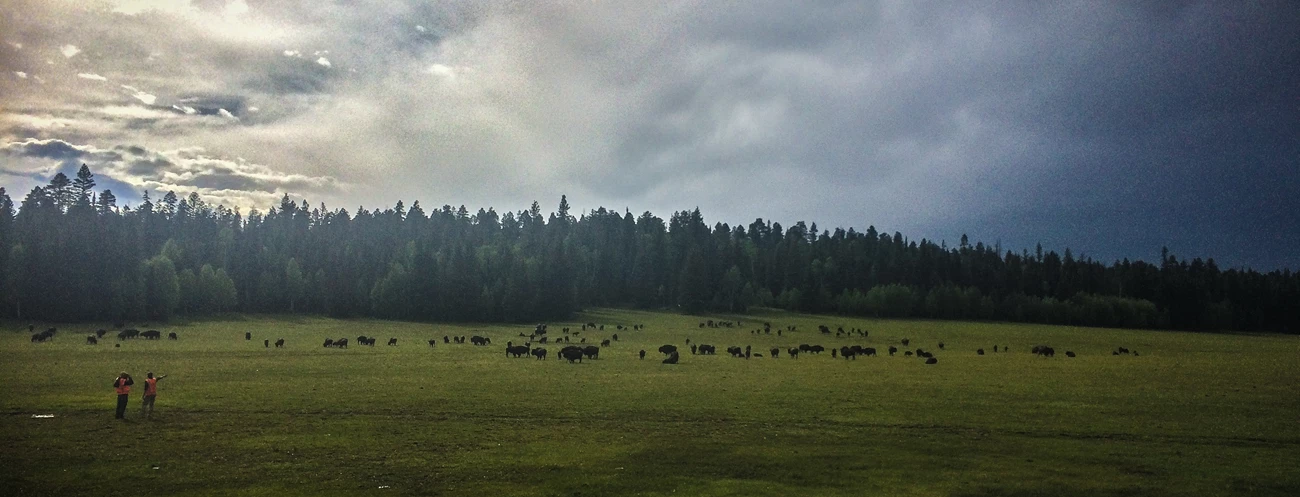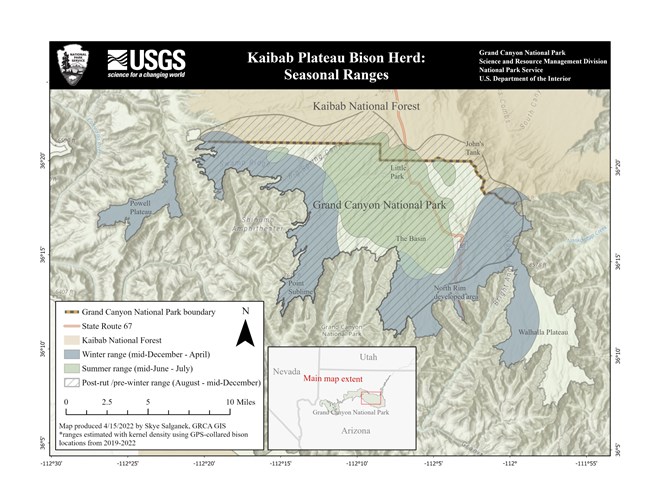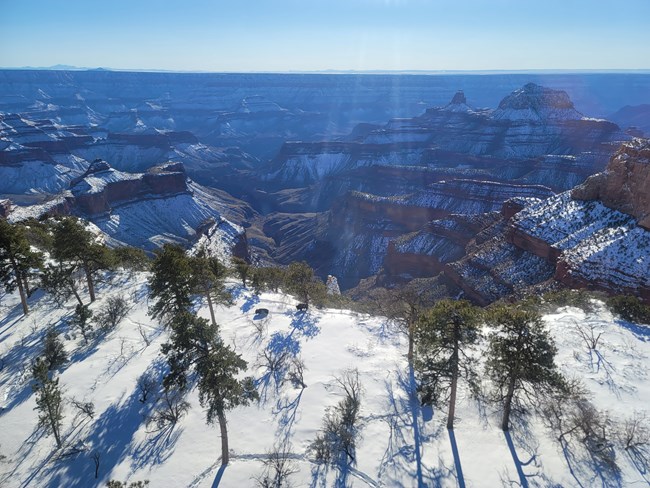Last updated: July 18, 2024
Article
Bison in Grand Canyon, the Kaibab Plateau Herd

NPS Photo/ S.Ciarrachi
Bison Safety
- Bison are wild animals and are unpredictable.
- Maintain a distance of 100 feet (30 m or two bus lengths) from bison.
- When the bison are within 100 feet (30 m) of the road, it is recommended to view them from inside a vehicle.
- Please use established gravel or paved pull-outs to park vehicles completely off the roadway (all wheels right of the white line). Do not walk or park in the road.
Kaibab Plateau Bison Herd: Historical Context
The present-day Kaibab Plateau Bison Herd originated from the Charles Jesse “Buffalo” Jones founder herd brought to Arizona in 1906. Arizona Game & Fish Department managed the herd starting in 1929 at approximately 100 bison, in the House Rock Wildlife Area within the Kaibab National Forest. In the 1990s, due to public hunting pressure, drought, reduced forage and fire, about 100 bison migrated to Grand Canyon National Park’s North Rim. Since 2010, the herd has primarily resided on the North Rim within Grand Canyon National Park. Outside of the Park, Arizona manages public hunts on the Kaibab National Forest. The Kaibab Plateau Bison Herd is physically separate from other Arizona wild bison herds (the House Rock Bison Herd and the Raymond Ranch Herd). It is currently co-managed by Grand Canyon National Park, Arizona Game & Fish Department, and the Kaibab National Forest and is designated as wildlife under Arizona state law and federal policy.

Salganek S; Terwilliger M; Schoenecker, K.A. 2022. Kaibab Plateau Bison Herd Seasonal Ranges. GeoDatabase in National Park Service Integrated Resource Management Applications Datastore 2293856. Grand Canyon National Park, Kaibab Plateau, Arizona, USA.
Tracking collar data on bison between 2019-2022 helped park biologists better understand the movement of bison in this free ranging herd. The Kaibab Plateau Bison Herd is seasonally migratory (see map). They spend their summers in the open meadows and near water sources where they are most likely to be viewed by the public. Water is clearly a limiting factor as they are more dispersed when there is more water on the landscape, such as during the summer monsoons. During the autumn period they range widely and are the most dispersed across their range. This is when they exhibit pioneering behavior to new areas. Members of the herd have moved up to five miles out of the park into the neighboring Kaibab National Forest. They spend their winters on the rim and up to 1,500 feet into the Grand Canyon, below the Kaibab Limestone, as well as on Powell Plateau.
For the spatial data see:
- Kaibab Plateau Bison Herd Seasonal Ranges. 2022. Salganek, Schoenecker, and Terwilliger. Geospatial Dataset Code 2293856. Grand Canyon National Park.
Kaibab Plateau Bison Herd Response to Hunting
Hunting is permited on the herd outside of park boundaries by Arizona Game & Fish Department. Recently, Grand Canyon and U.S. Geological Service biologists completed a study on the influence of hunting on bison movement and habitat selection on the herd. In summary, despite no physical boundary, bison showed strong avoidance of the U.S. Forest Service / Grand Canyon boundary using the Park as a refuge. They also move more quickly when on Forest Service lands where they are hunted. Interagency managers can use this to inform future management.
Read the whole paper here:
- Using integrated step selection to determine effects of predation risk on bison habitat selection and movement. 2024. Salganek, Schoenecker, and Terwilliger. Ecosphere 2024:e4909. https://doi.org/10.1002/ecs2.4909
Based on tribal oral histories, historic range maps, and archeological evidence bison on the North Rim are either outside of their historic range or at the extreme edge of it. There is disagreement among scientists on which model is correct and it is unlikely that this will be answered definitively in the absence of new information. Regardless, it is likely that if bison occurred on the Plateau they would have occurred in small intermittent numbers at low density.
- Grand Canyon bison nativity, genetics, and ecology: Looking forward. Natural Resource Report. 2016. Plumb, Sturm, McMullen, Holm, Lutch, Keckler, Gatto, Munig, and Wallen. NPS/NRSS/BRD/NRR—2016/1226. National Park Service. Fort Collins, Colorado

Terwilliger ML, Hartway CR, Schoenecker KA, Holm G, Zeigenfuss LC, Swan M, Salganek D, Buttke D, Musto DT. 2020. Management of the Kaibab Plateau bison herd in Grand Canyon National Park: 2018–2019 operations report. Natural Resource Report. NPS/GRCA/NRR
Kaibab Plateau Bison Herd Genetics
Herd founder, Charles "Buffalo" Jones, attempted to hybridize bison with cattle in the 1800’s, as did most other owners of founding herds, which was mostly unsucessful. Genetic microsatellite analyses of the herd from samples collected in 2003 and 2019-2021 confirm this legacy (cattle genes in bison is called intogression). There are two types of DNA tested for: mitochondrial DNA (mtDNA) and nuclear DNA (nDNA). The mtDNA is inherited through the mother only, composes 0.25% of a cell's genetic makeup, is not affected by evolutionary forces, and is primarily responsible for cell energy production. The nuclear DNA (nDNA) is inherited through both parents, composes 99.75% of a cell's genetic makeup, is affected by evolutionary forces, and is responsible for heritable traits such as eye and hair color.
In comparison to 20 other wild bison conservation herds, the Kaibab Plateau Bison Herd cattle mtDNA is very high. However, the level of cattle genes in nDNA is ~1.6%, which is on the high end of the same 20 herds, but roughly equivalent to what has been detected in the herd at Custer State Park (1.5%), Badlands National Park (1.3%) and the Theodore Roosevelt National Park North Unit herd (1.4%). This new genetic information, their physical features, and behavior show that the Kaibab Plateau herd are bison (not cattelo or beefalo).
When comparing the Kaibab Plateau Bison Herd with 19 other wild conservation herds, the herd is significantly genetically different, but is most genetically similar to the herds at Wind Cave National Park and Wichita Mountain National Wildlife Refuge (see Figure). This is not surprising as bulls have been introduced from these herds in the past. The Kaibab Plateau Herd has unique bison alleles in the nDNA not found in any other tested herd. Whether these genes are from founding genetics or have evolved since then is unknown. These alleles can be valuable to the conservation of the species. Small but regular introductions from other populations (6 additions over 72 years) appear to have prevented genetic bottlenecking (or inbreeding depression) and genetic drift that would be expected otherwise in a small, isolated herd.
For more in-depth information on genetics see the following reports:
- Management of the Kaibab Plateau bison herd in Grand Canyon National Park: 2018–2019 operations report. 2020. Terwilliger, Hartway, Schoenecker, Holm, Zeigenfuss, Swan, Salganek, Buttke, and Musto. Natural Resource Report NPS/GRCA/NRR—2020/2167. National Park Service, Fort Collins, Colorado.
- Long-term viability of Department of the Interior bison under current management and potential metapopulation management strategies. 2020. Hartway, Hardy, Jones, Moynahan, Traylor-Holzer, McCann, Aune, and Plumb. Natural Resource Report NPS/NRSS/BRD—2020/2097. National Park Service, Fort Collins, Colorado.
Herd Health & Disease Survelliance
Due to their isolation from other herds, the Kaibab Plateau Bison Herd is relatively disease free. Samples for disease monitoring have been taken from carcasses and all captured bison. The herd has been monitored for a variety of diseases common to bison. To date bison have tested negative for brucellosis, Bovine Viral Diarrhea, Johnes disease, Mycoplasma bovis, parasites, and mineral deficiencies.
- Department of the Interior: History and status of bison health. Natural Resource Report. 2020. Jones, Powers, Sweeney. NPS/NRSS/BRD/NRR—2020/2201. National Park Service. Fort Collins, Colorado.
The U.S. Geological Service and the National Park Service collaborated to see if aerial thermal infrared surveys would be better than standard helicopter or airplane aerial surveys for estimating population size. For Grand Canyon National Park bison counts, we found traditional surveys work best.
- Comparison of Aerial Thermal Infrared Imagery and Helicopter Surveys of Bison (Bison bison) in Grand Canyon National Park, USA. 2021. Hennig, Schoenecker, Terwilliger, Holm, and Laake. Sensors 21(15): 5087

NPS Photo/J. H. Thompson
Related information:
